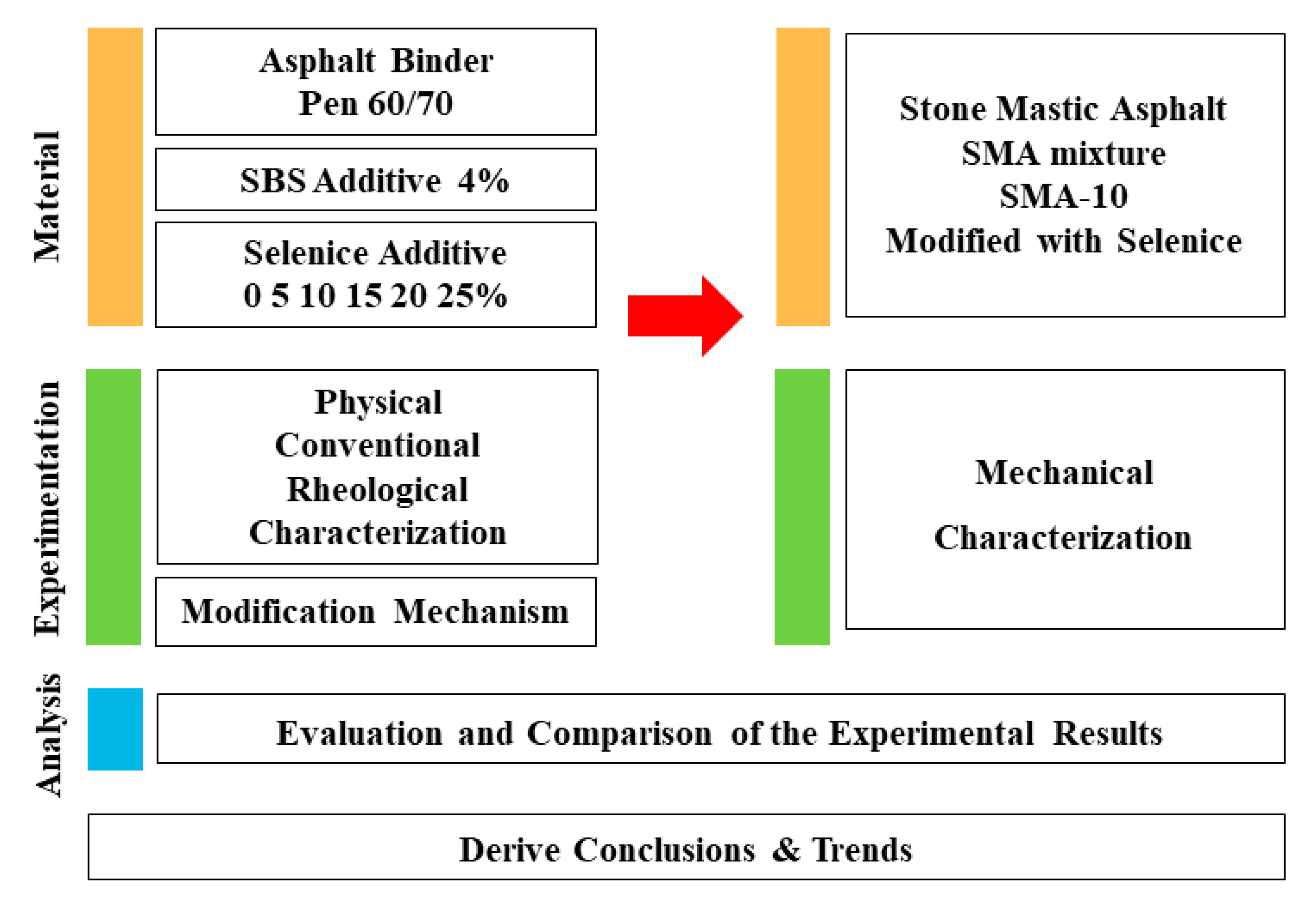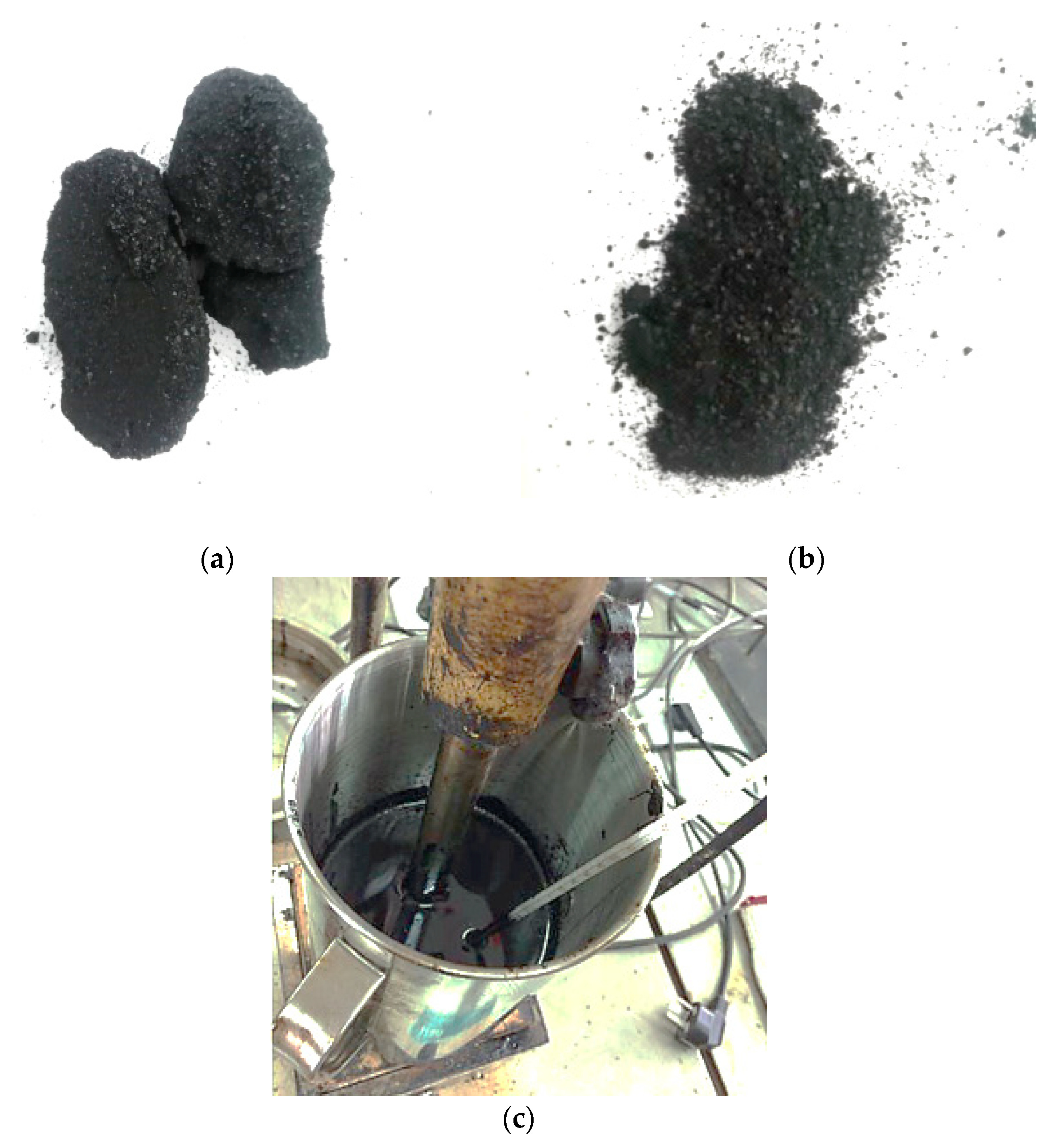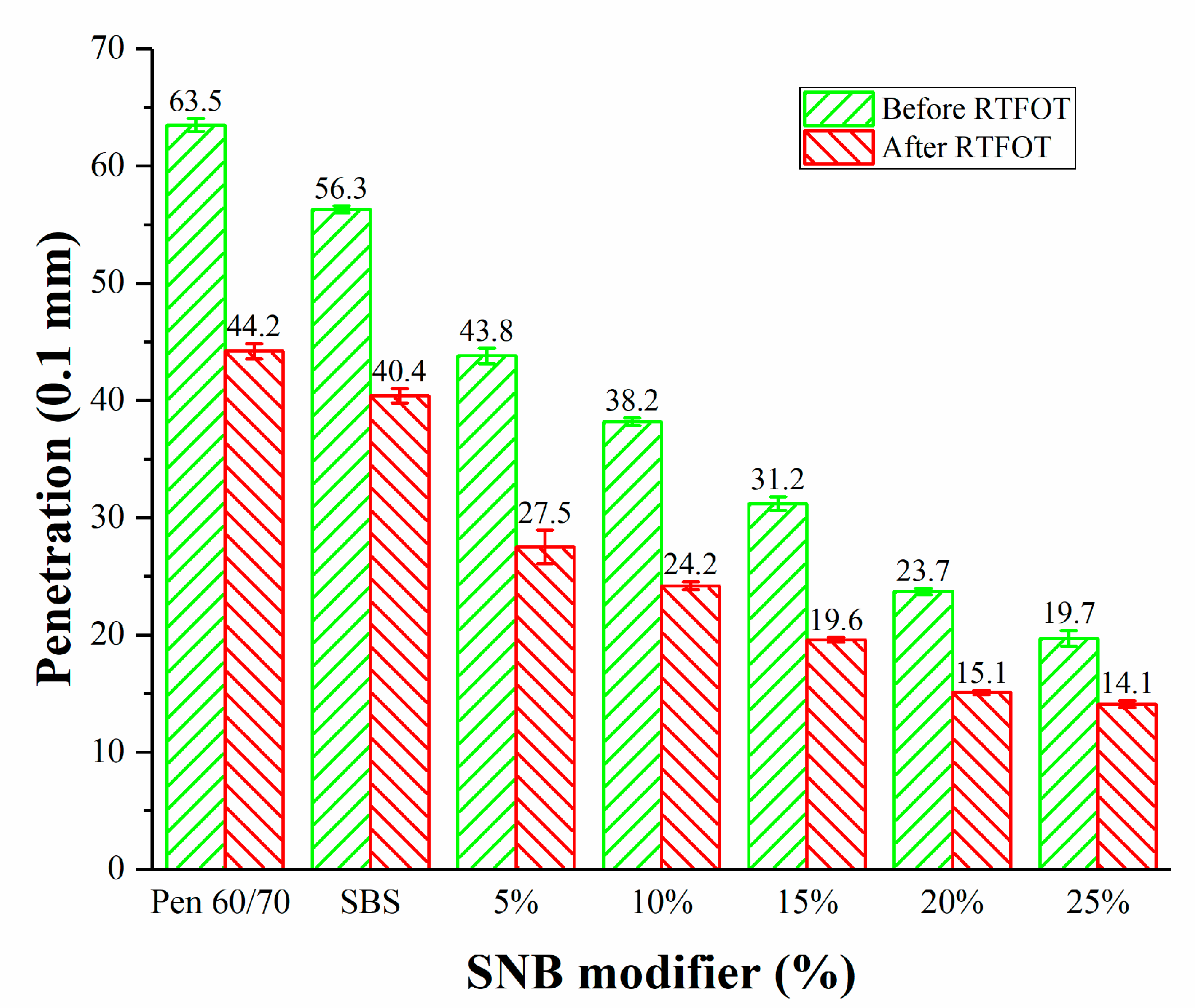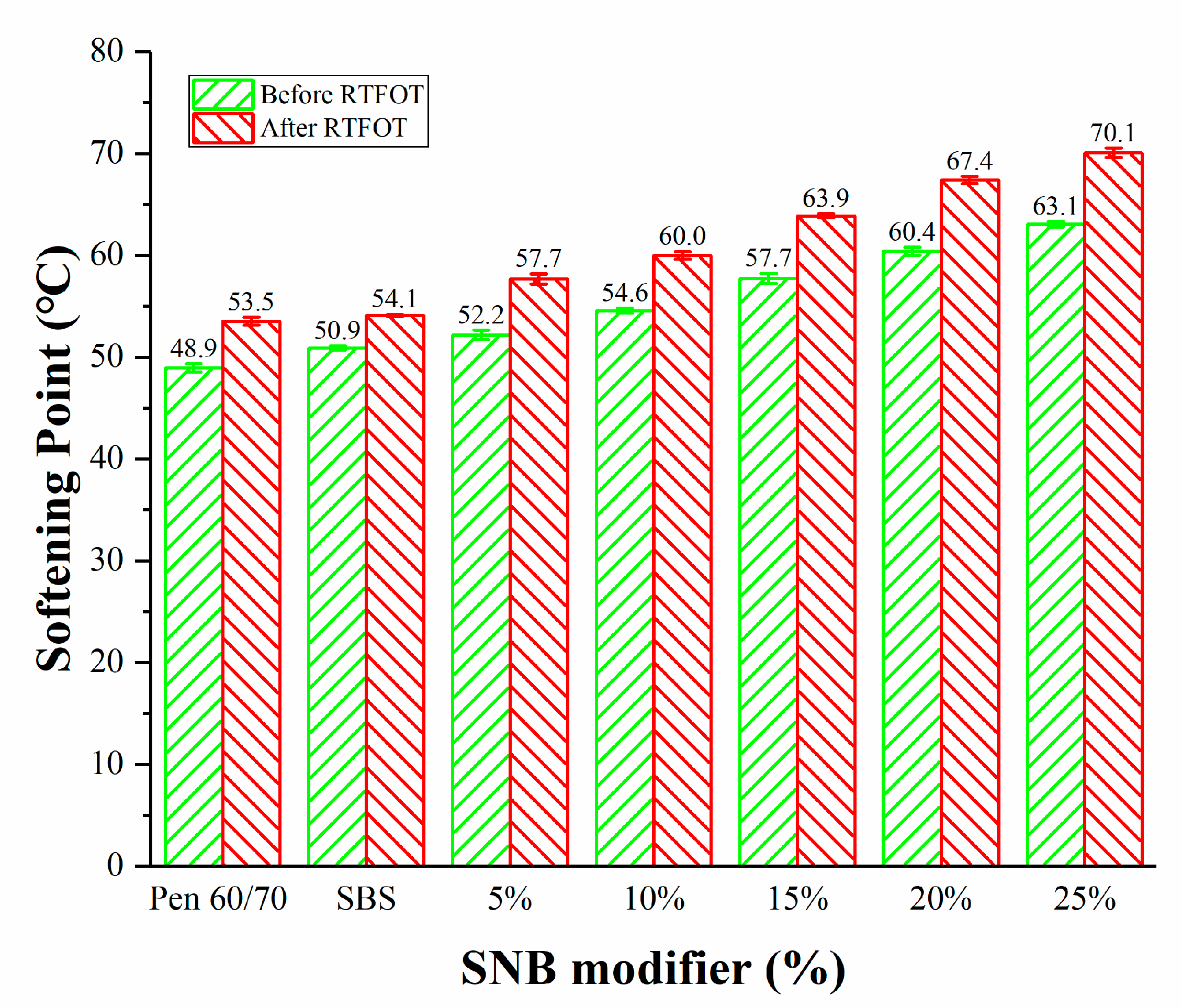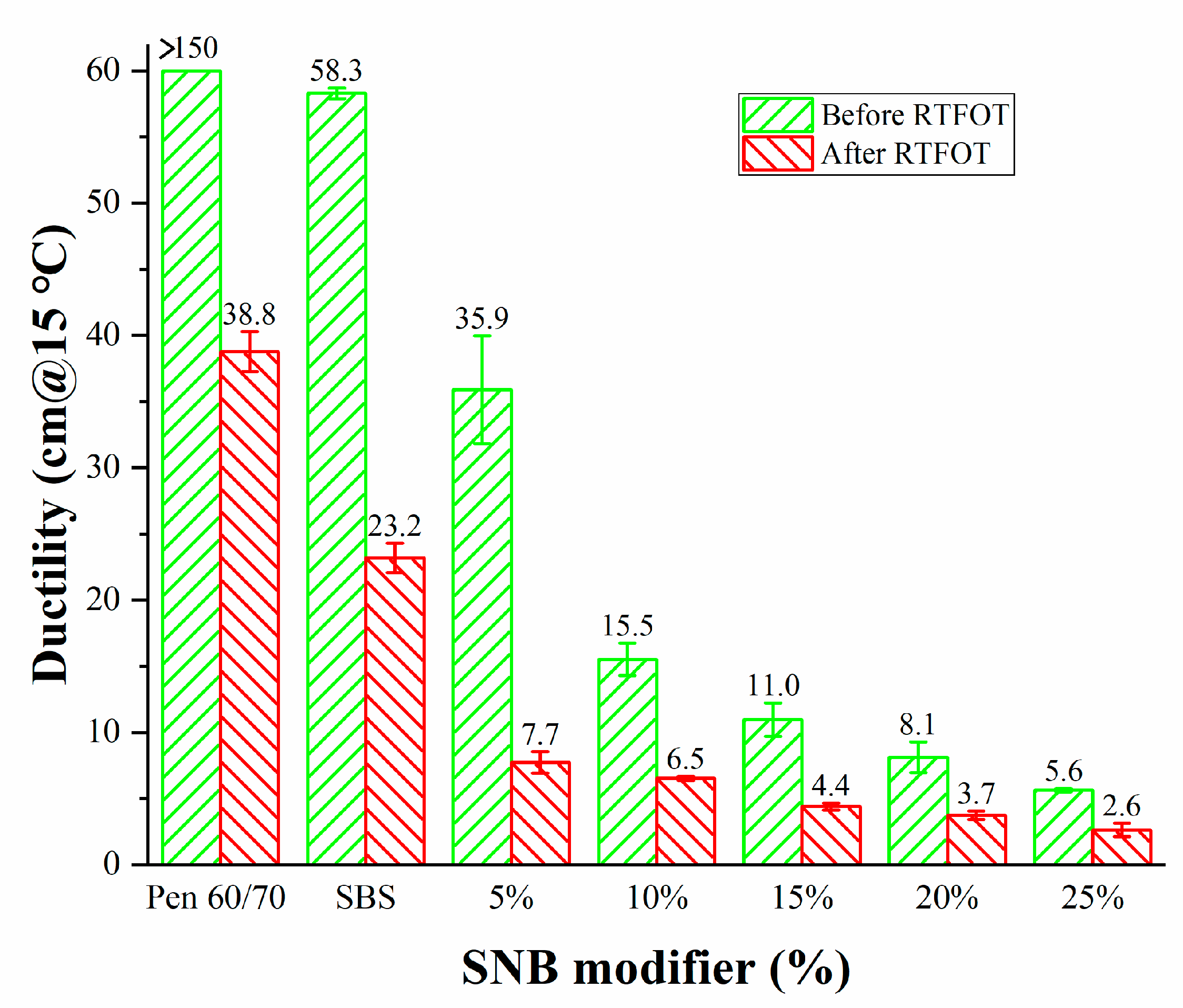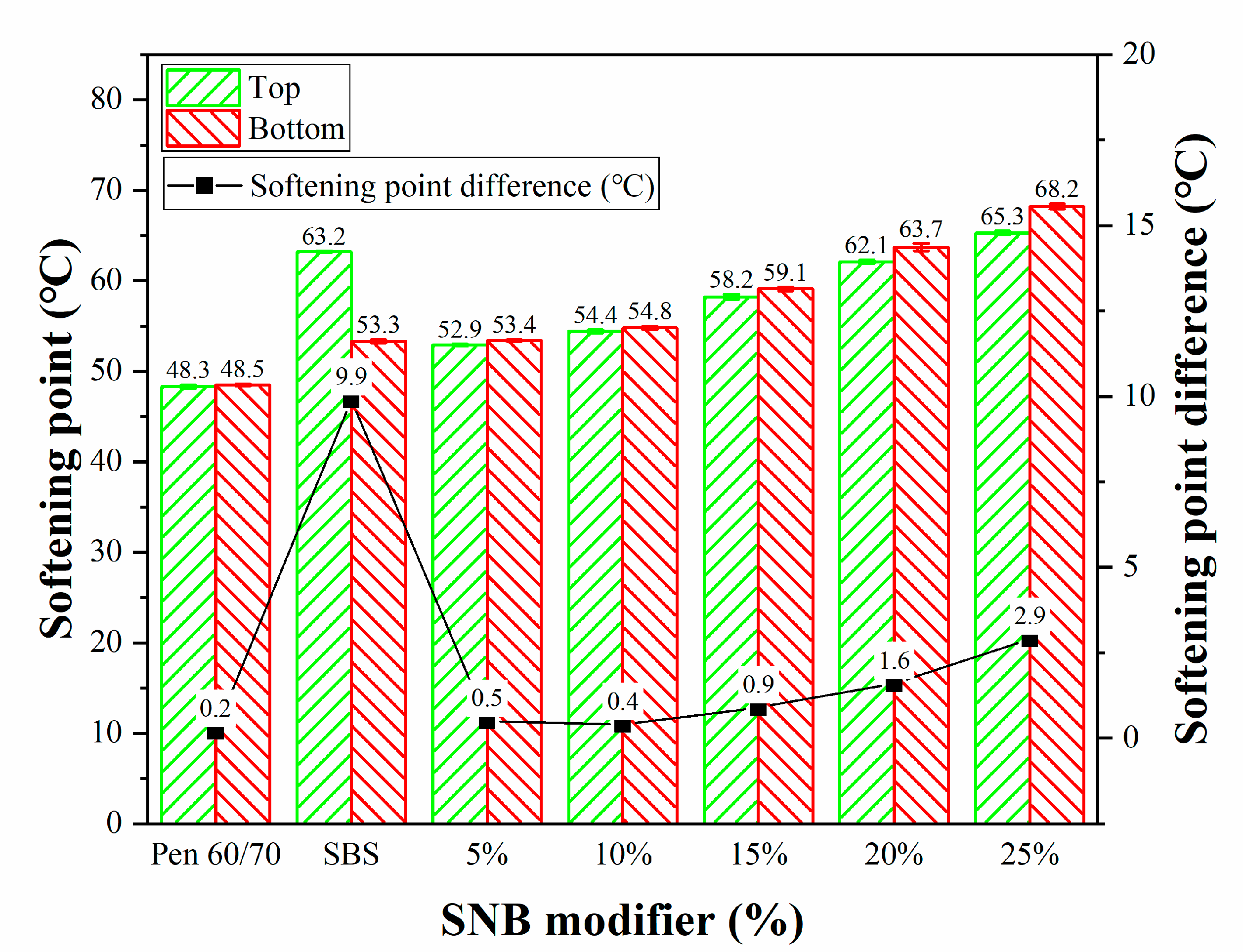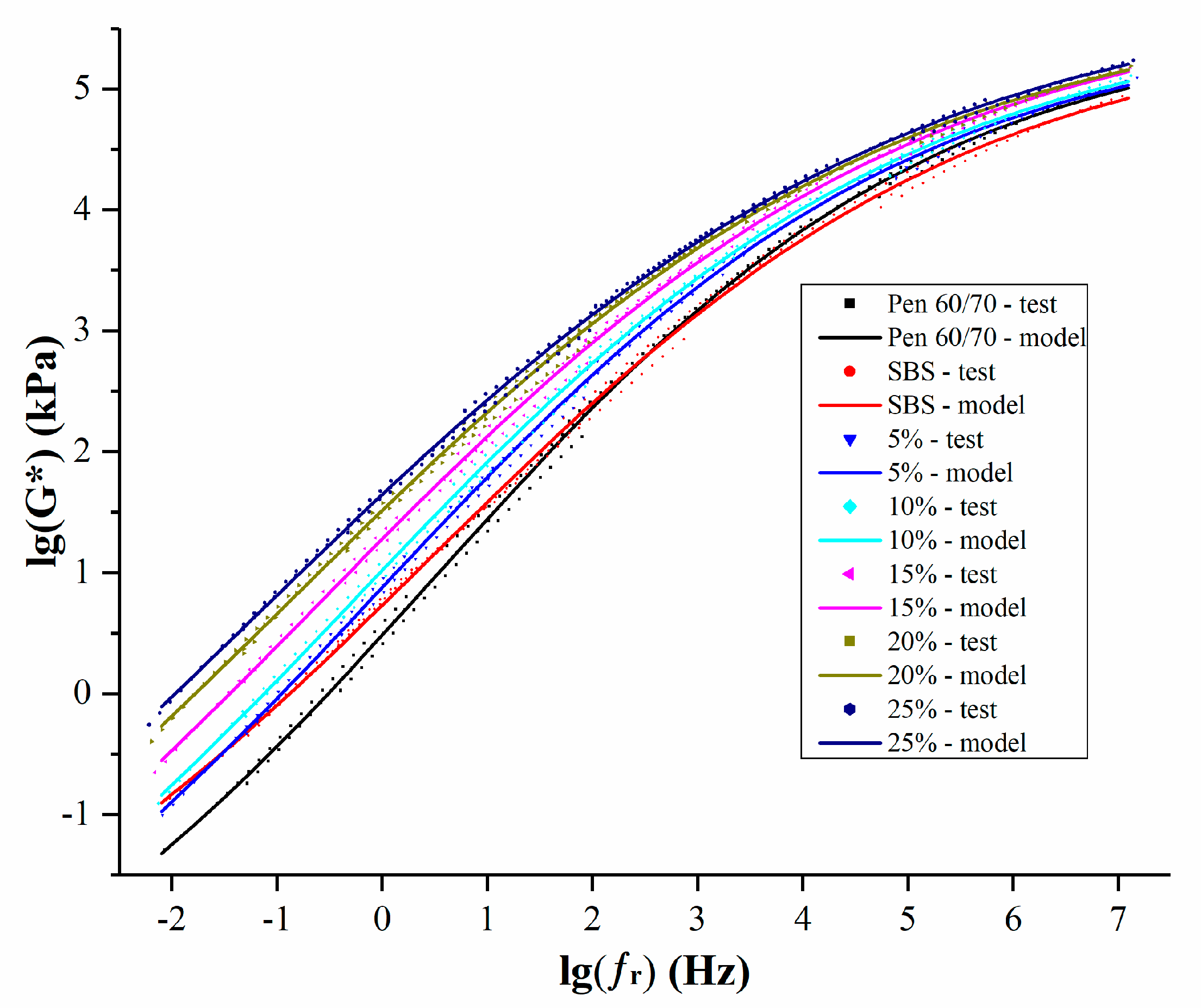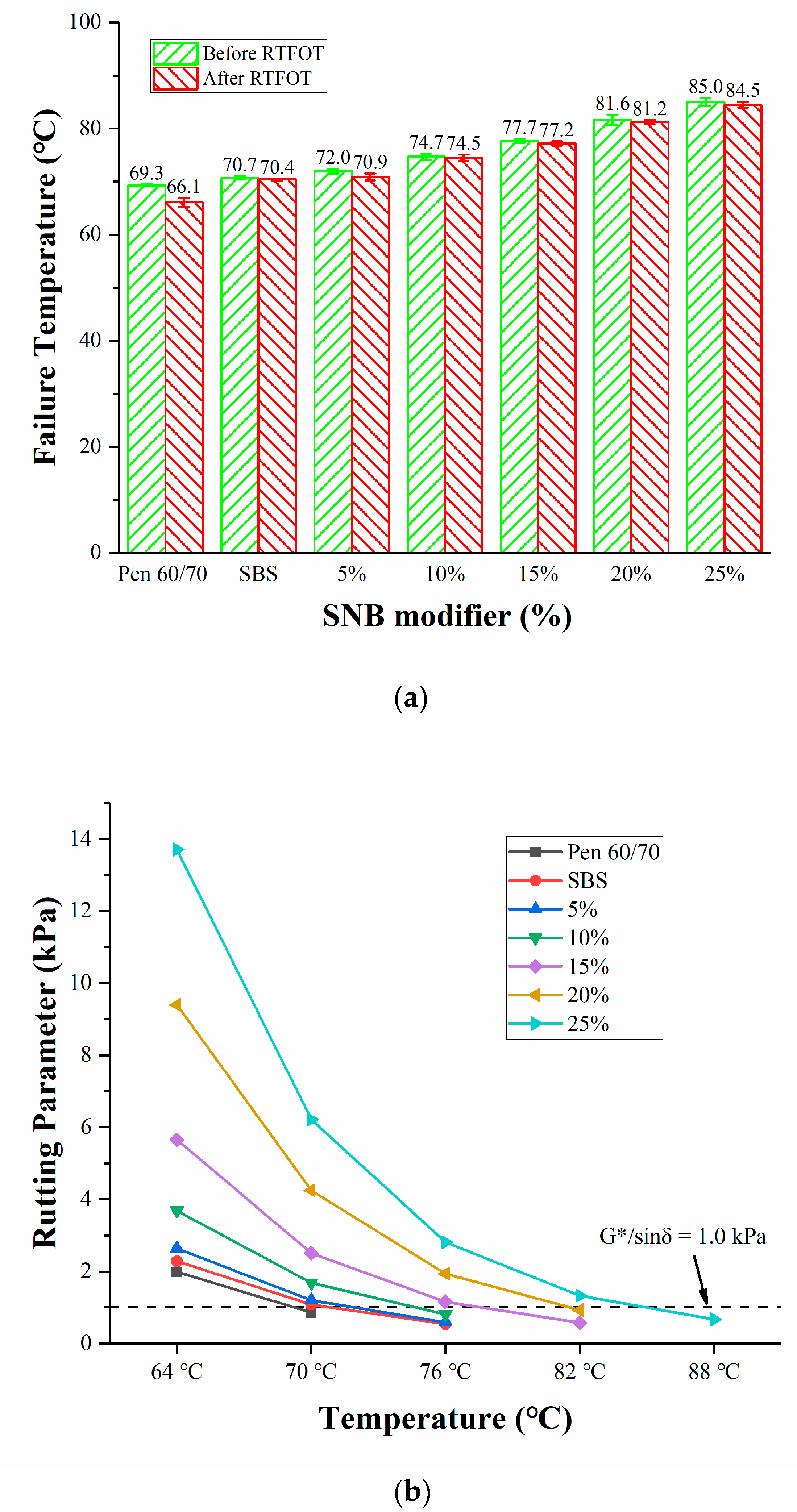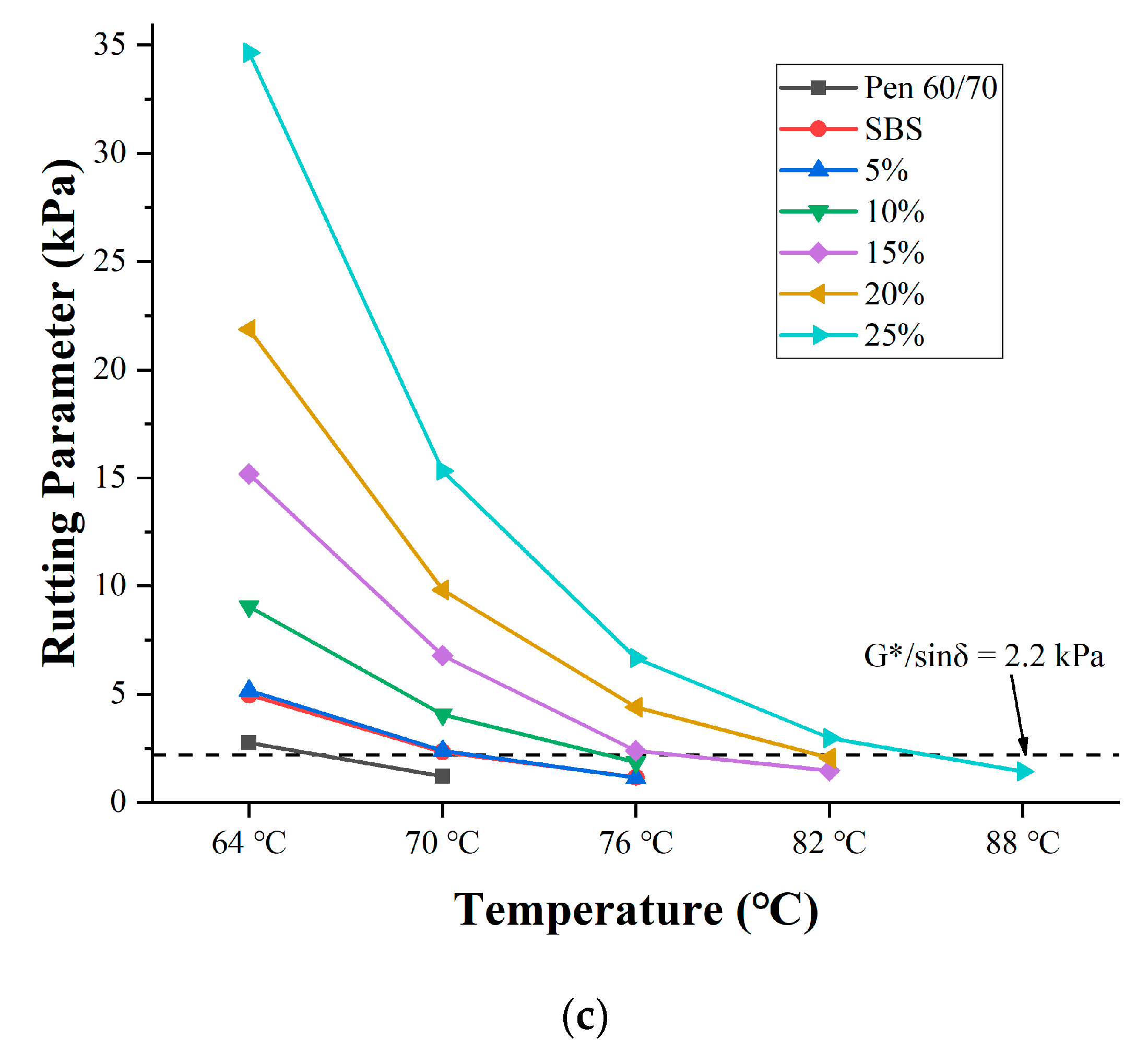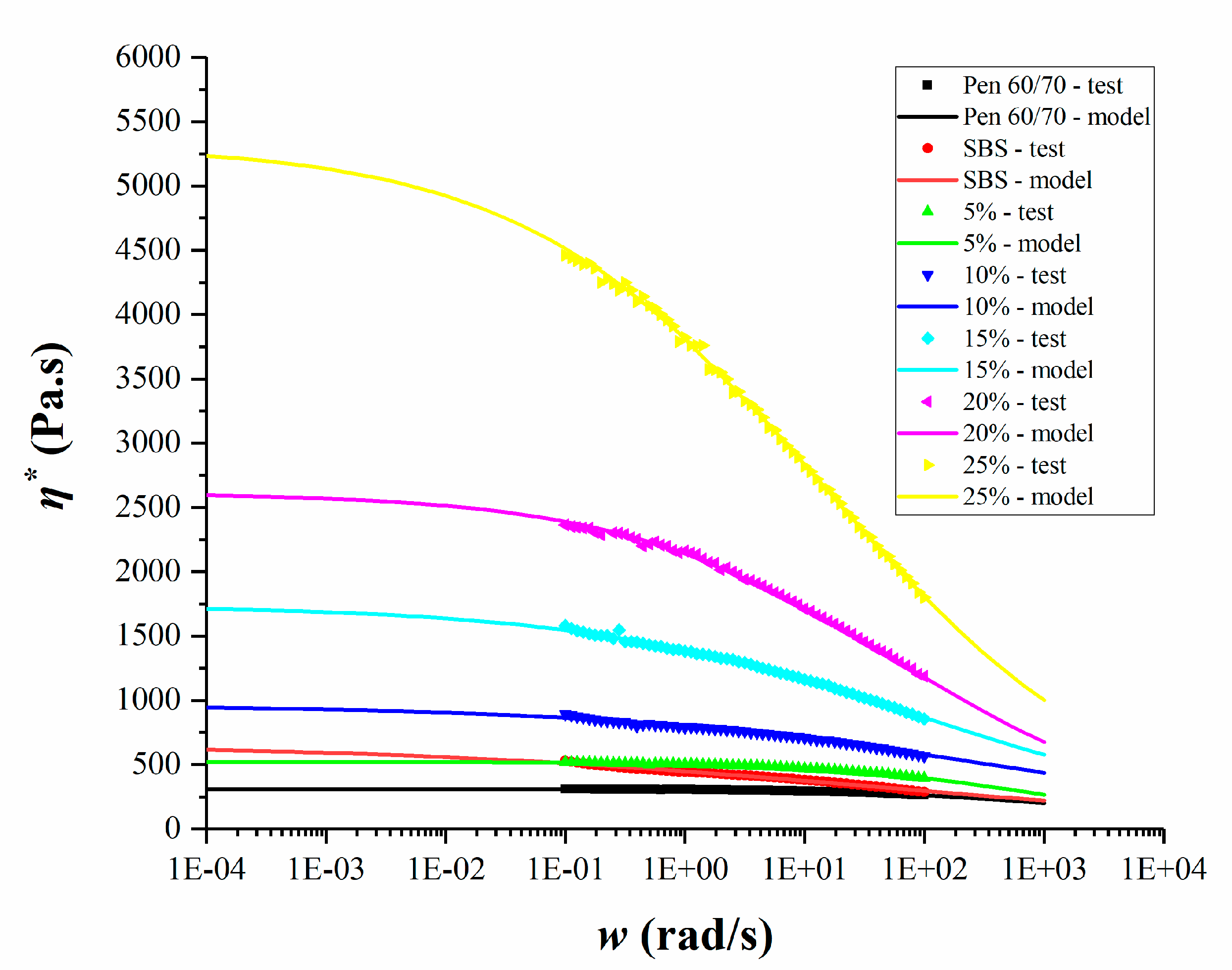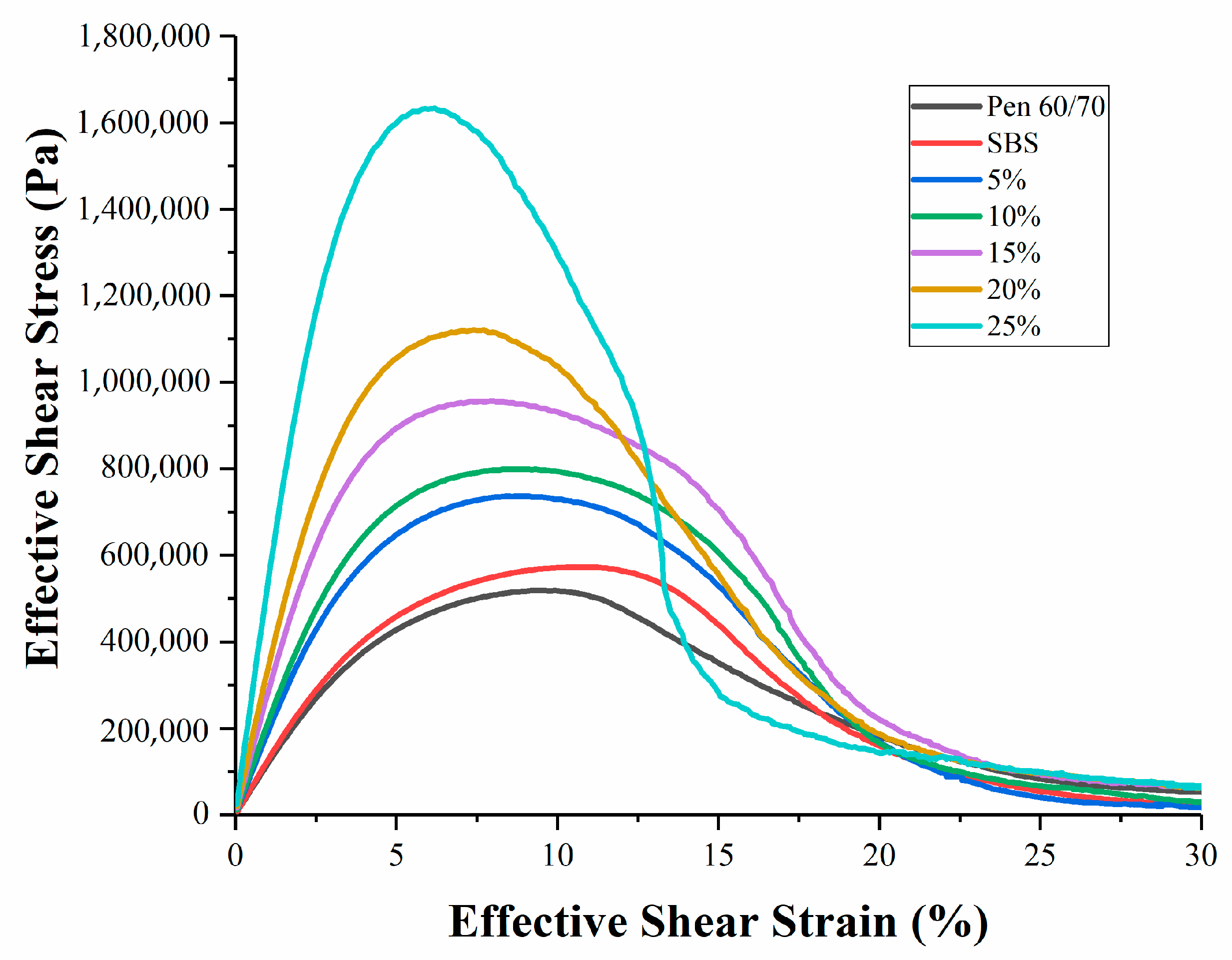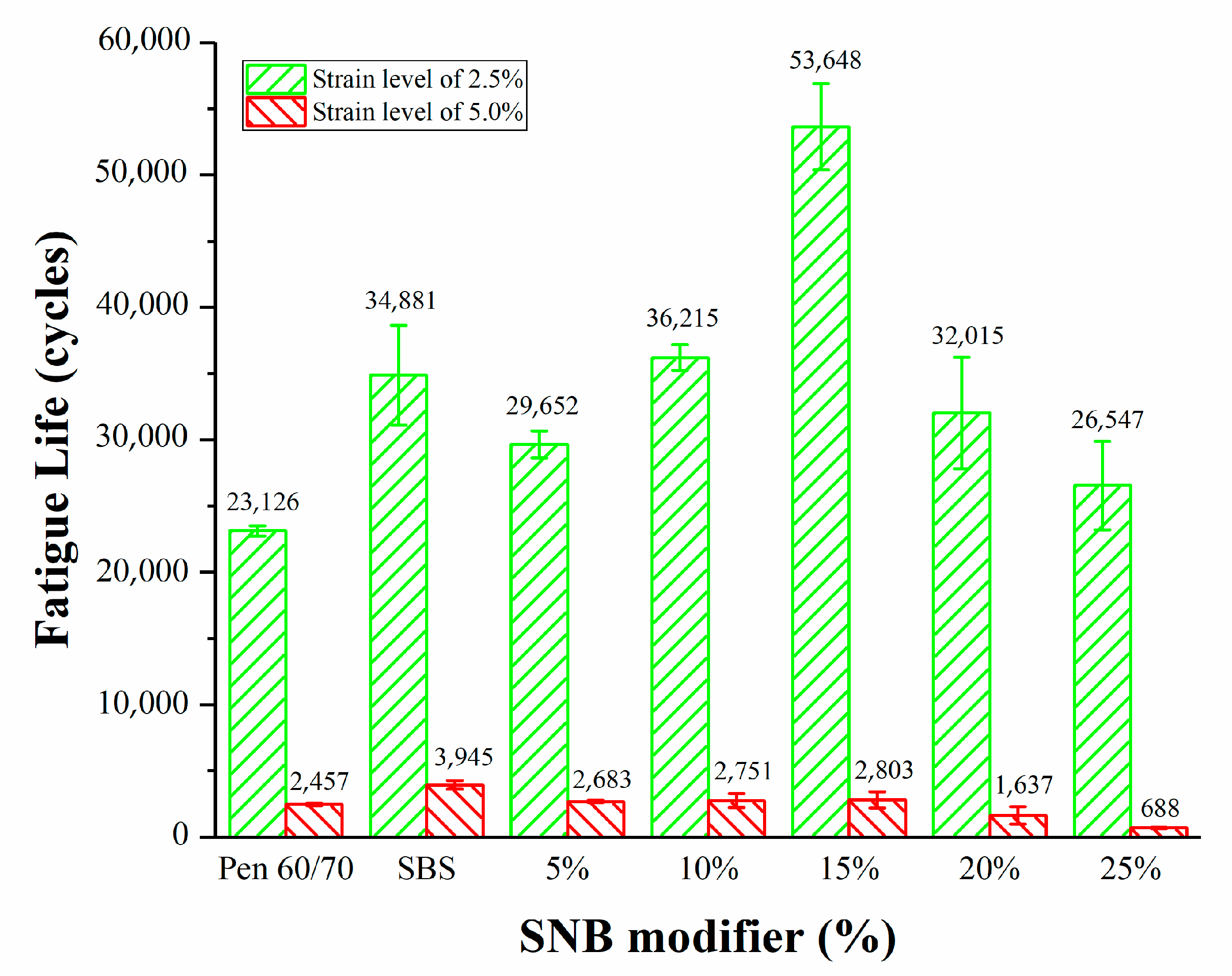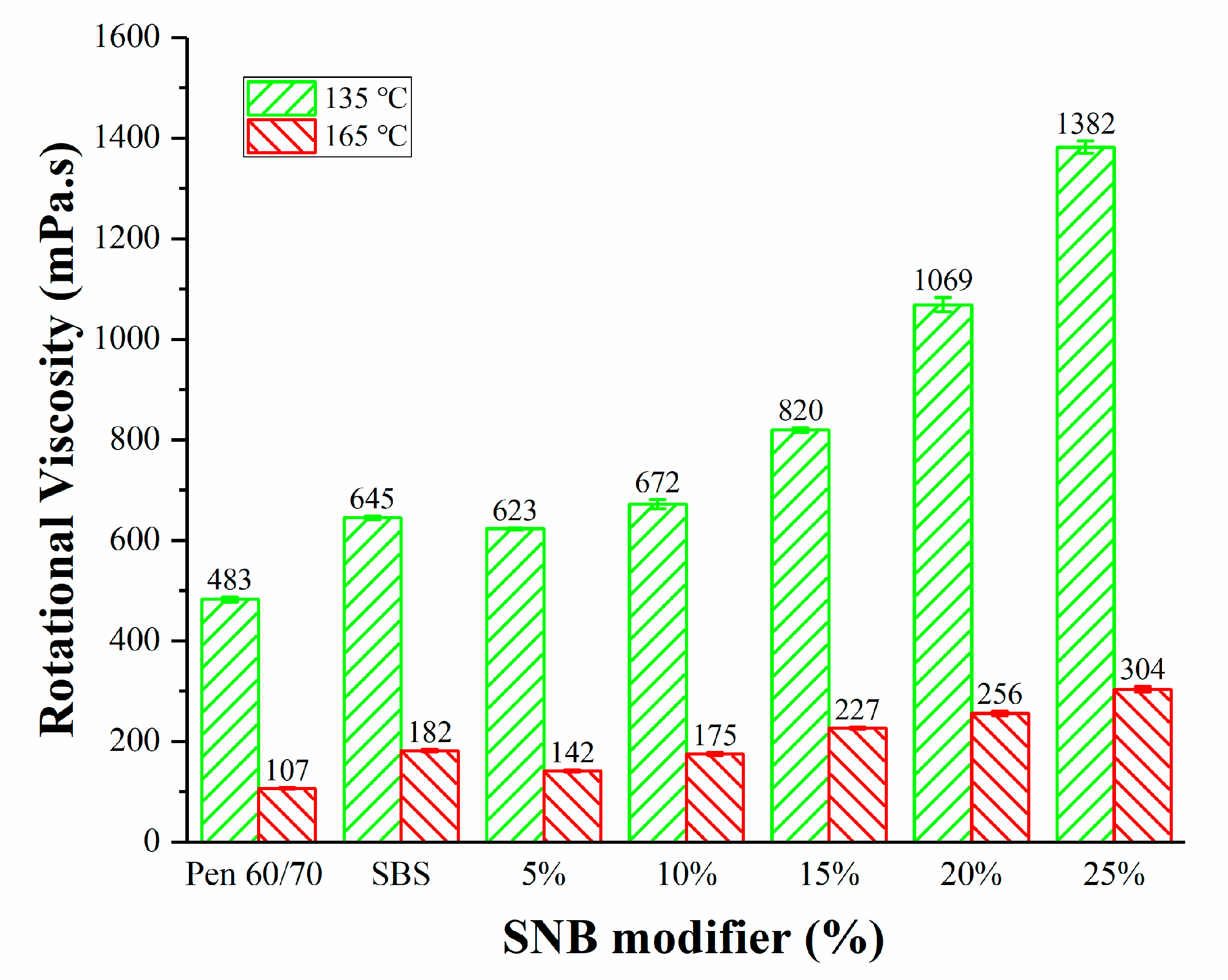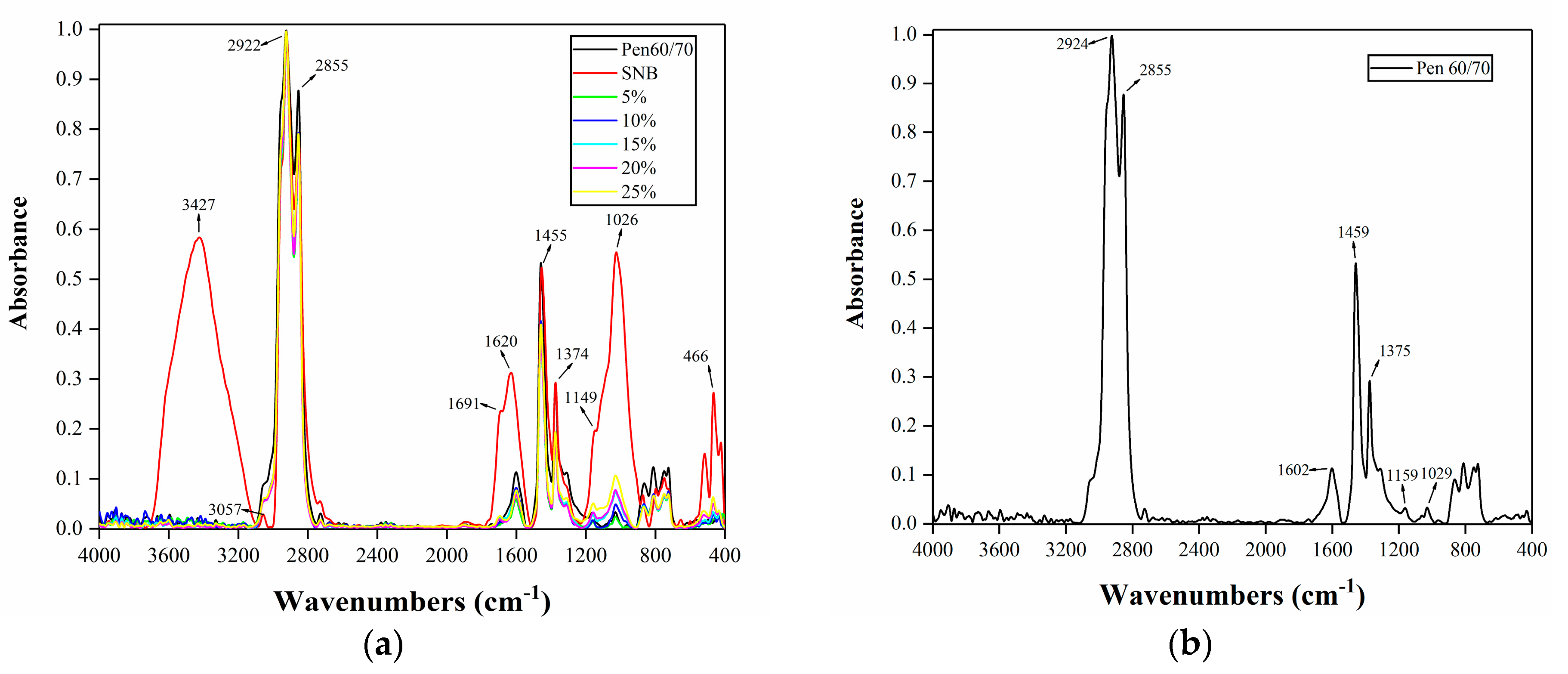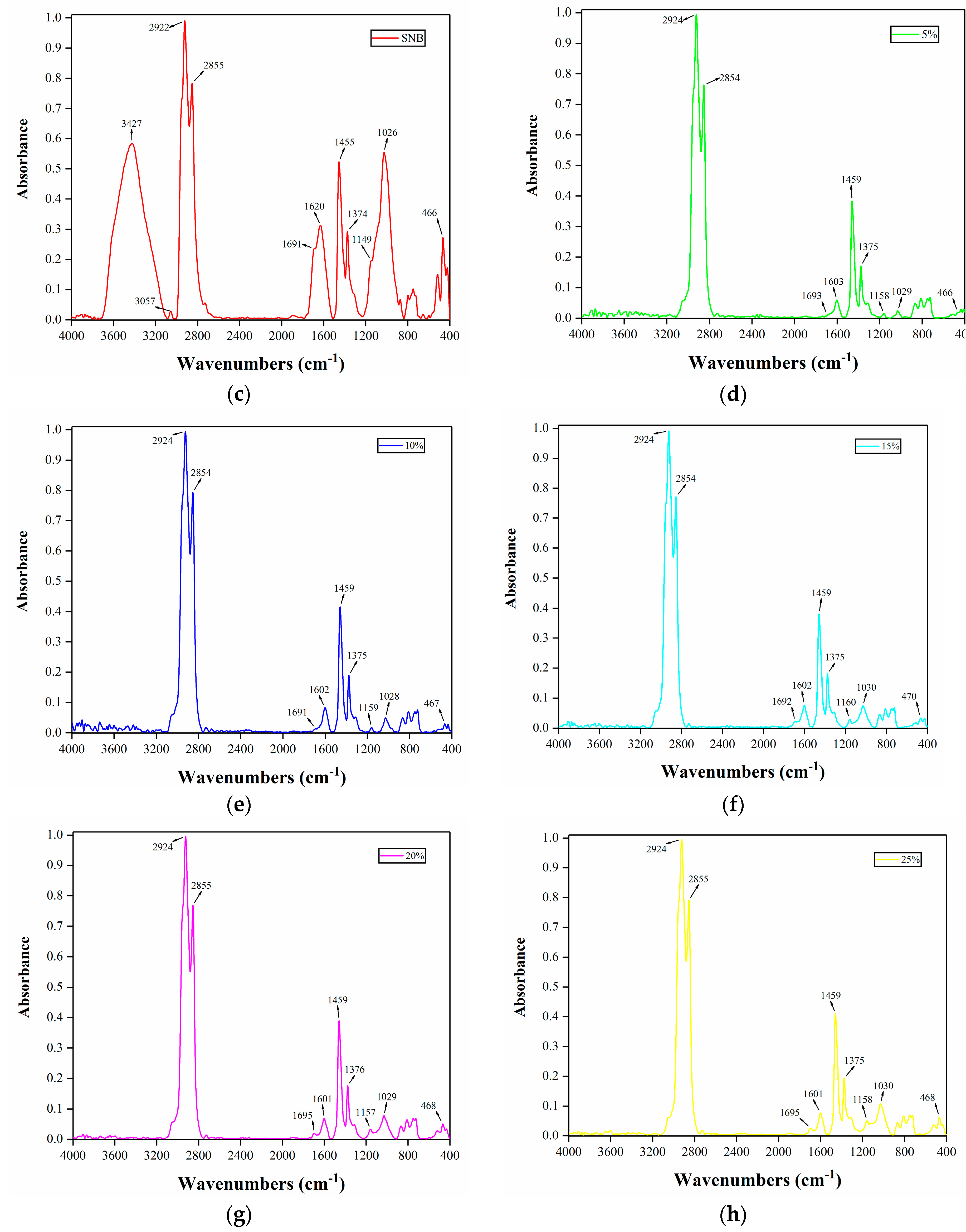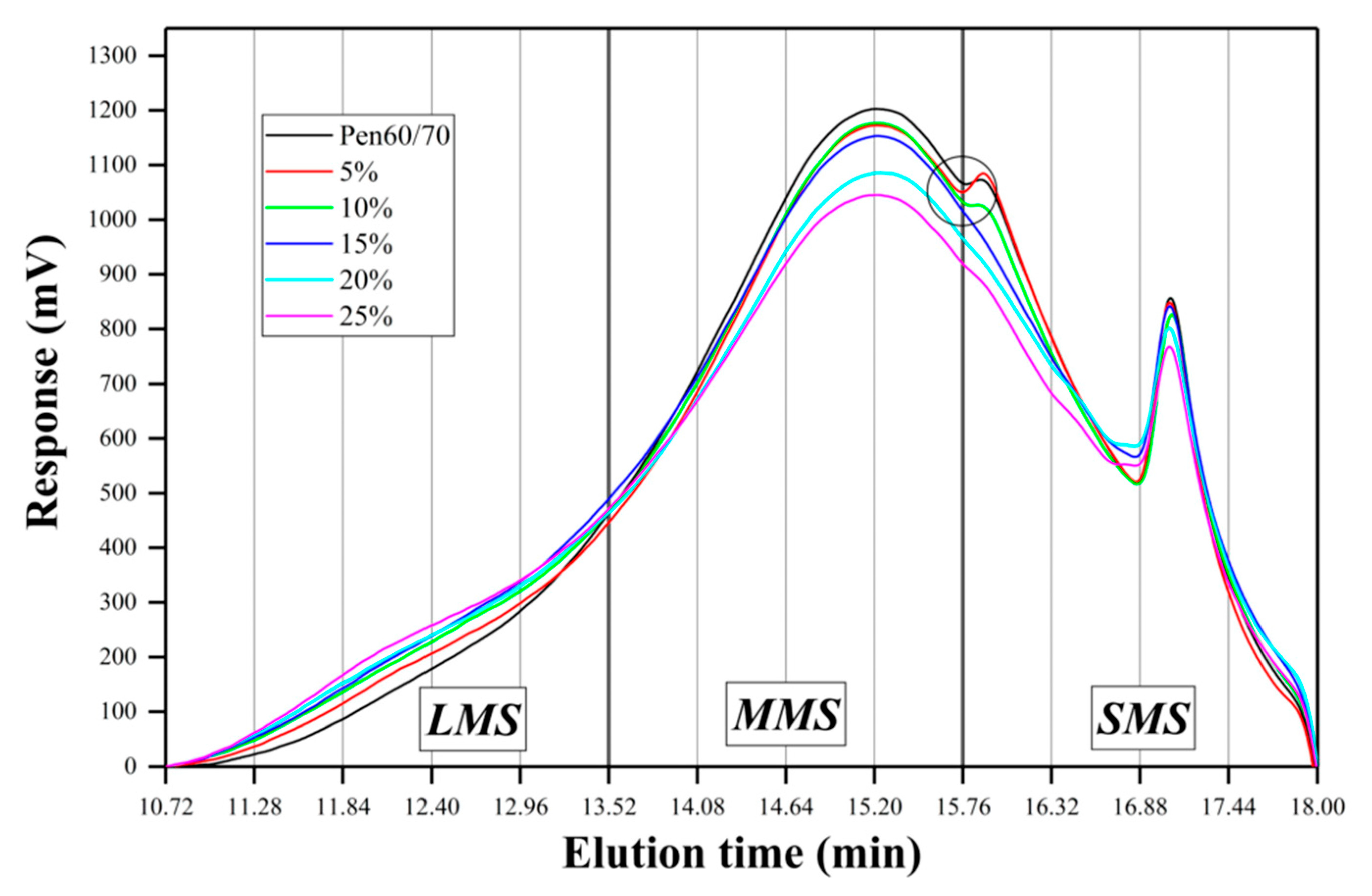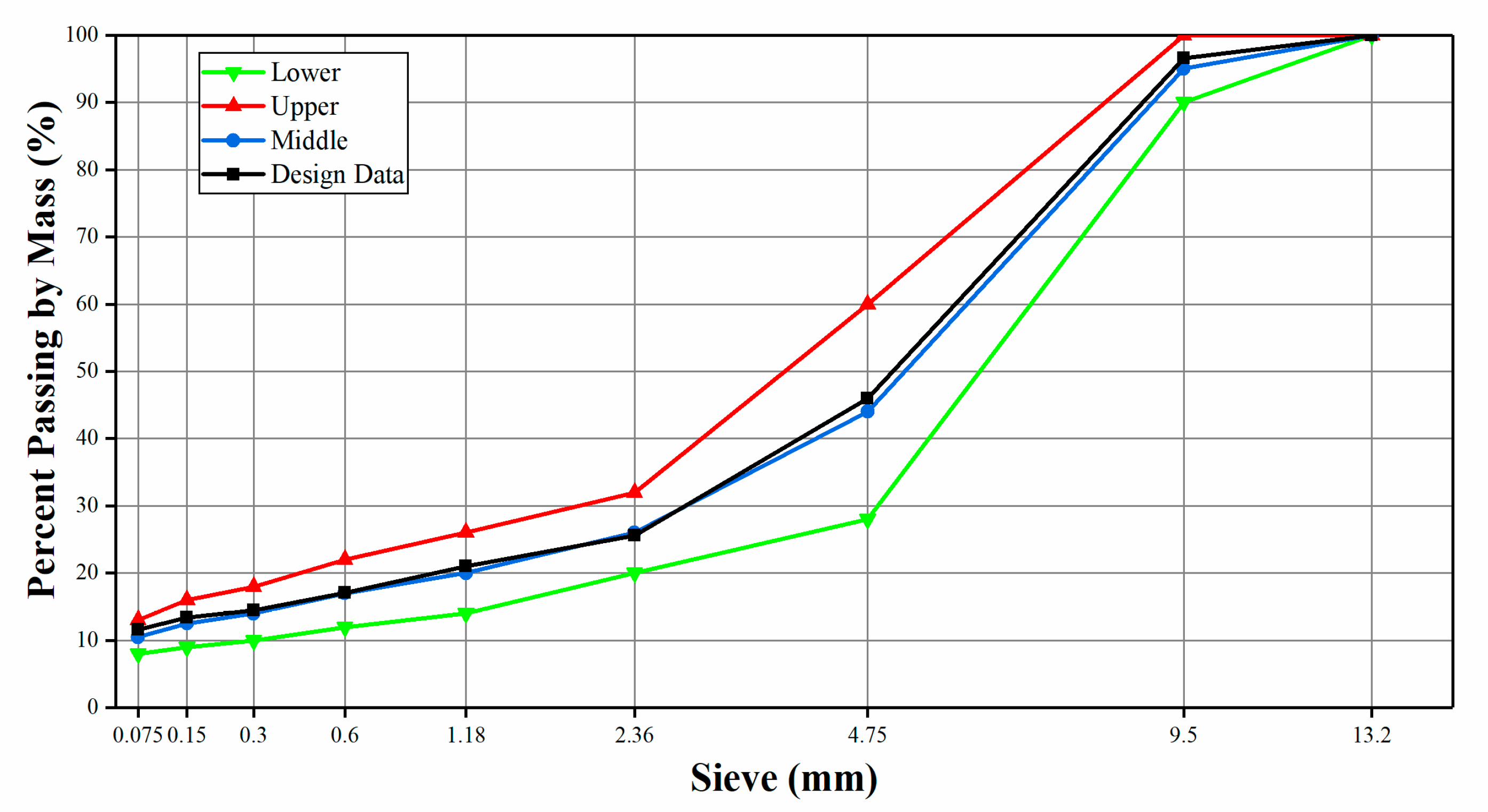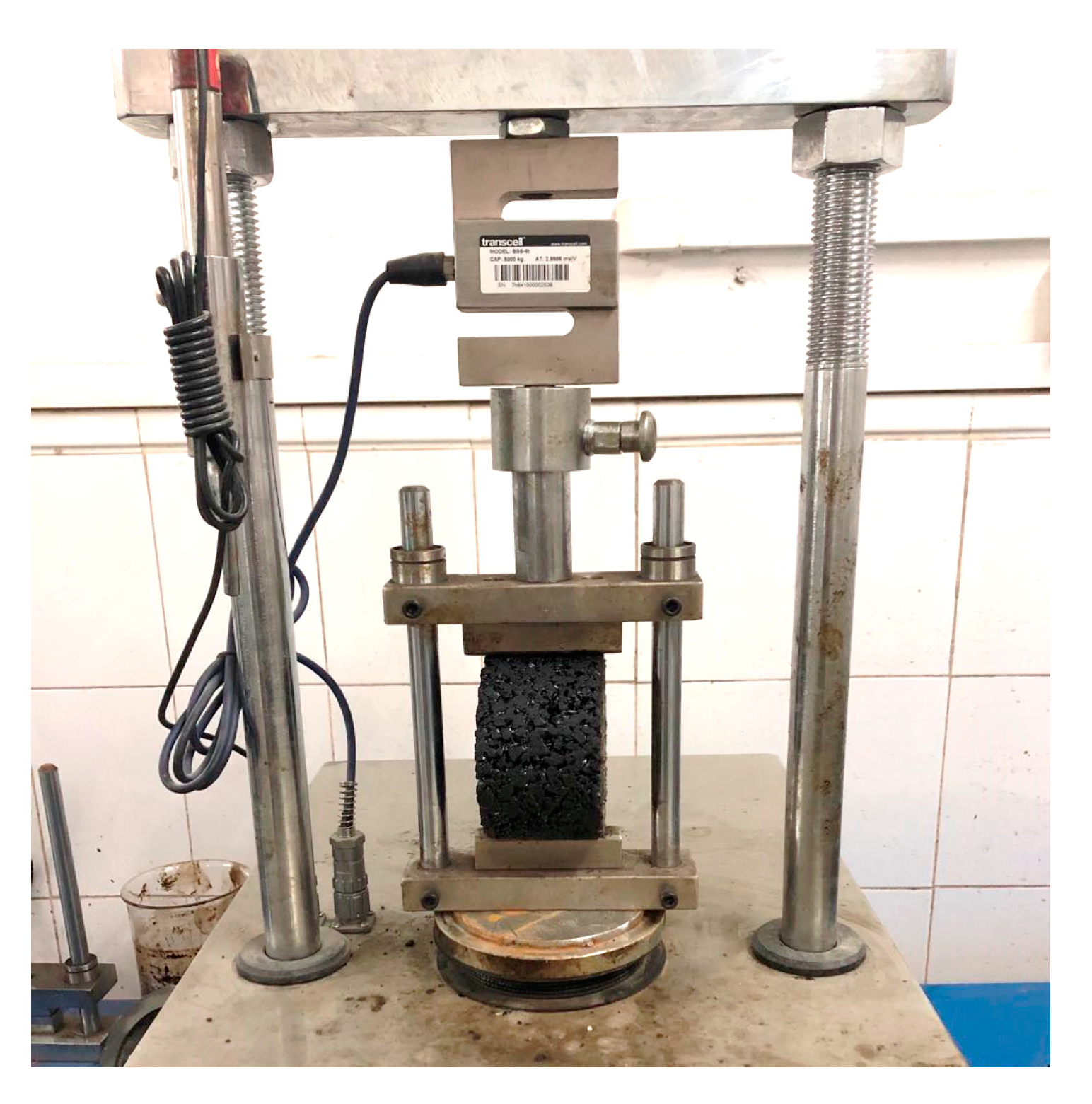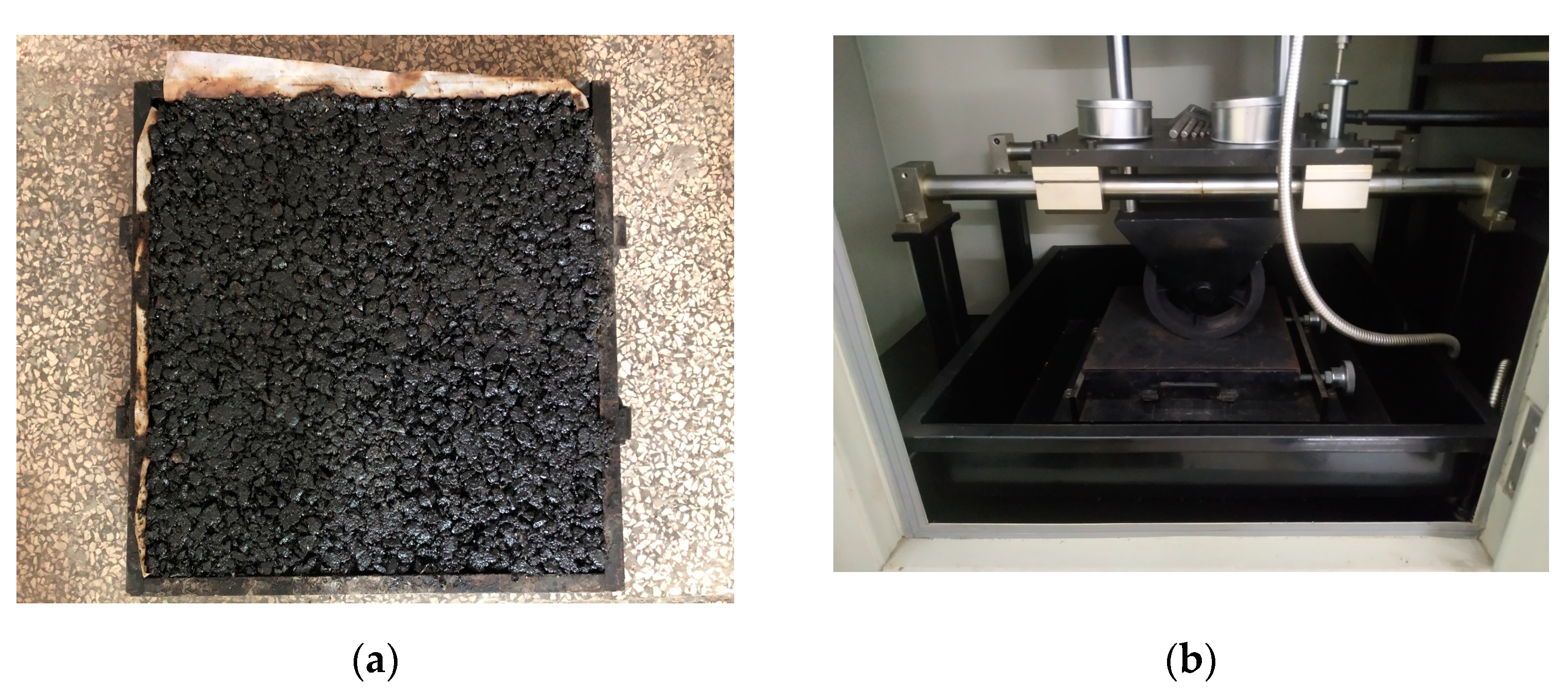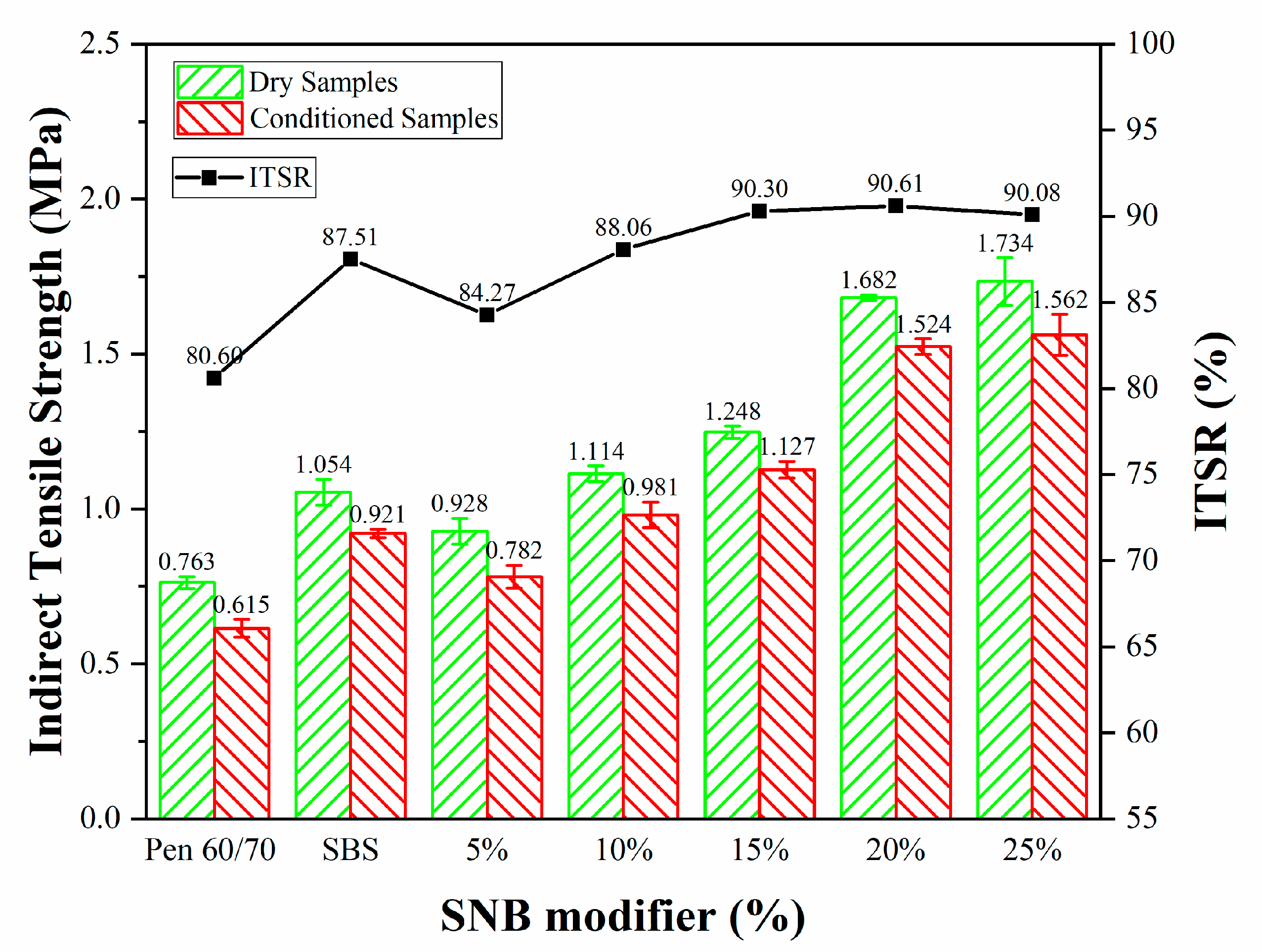3.1. Preparation of the SNB Modified Asphalt Binder
A virgin asphalt binder commonly adopted for paving purposes in the south of China was selected for the present research as reference material. The binder, which presented a penetration grade of 60/70 (Pen 60/70) (JTG E20 T0604-2011) [
32], was initially characterized (
Table 1) and then used to prepare SNB modified binder blends.
The blocks and agglomeration of SNB (
Figure 2a) were first reduced to finer material (
Figure 2b) through a grinding and crushing process. The size of finer SNB particles was roughly 1 mm (in the range of mesh 18) and the moisture content of SNB in its natural state was 2.46%. Then, the SNB in its natural state was preheated to remove the moisture in the binder blends to be prepared with the Pen 60/70 binder. Blending was initially performed with a glass rod for 15 min at a temperature of 165 °C, followed by the action of a high shear blending at 10,000 rpm for an additional 45 min (
Figure 2c). SNB was added to the blend at different percentages: 0% (control), 5%, 10%, 15%, 20% and 25% by weight of SNB modified asphalt binder. Each batch of blend consisted of approximately 1.2 kg of SNB modified binder.
In order to better explain the performance of SNB modified asphalt, an additional control material group, including SBS modified asphalt was prepared. Star-SBS was added to the blend at 4% by weight of SBS modified asphalt binder. Blending was performed in two steps; first, SNB was mixed by shear blending at the speed of 1000 rpm at a temperature of 170 °C for 15 min; then, the second round of mixing was imposed with a high shear blending at the speed of 5000 rpm for an additional 45 min. Each batch of blend consisted of approximately 1.2 kg of SBS modified binder.
3.2. Experimental Program for SNB and SNB Modified Asphalt Binder
The SNB additive was first evaluated in terms of physical properties. For this purpose, the amount of ash in the SNB was obtained according to the current standard on the bitumen ash content test at 900 °C (JTG E20 T0614-2011) [
41]. In addition, the actual asphalt binder content of the SNB additive was obtained by ignition at 538 °C (JTG E20 T0735-2011) [
42] as conventionally performed for hot mix asphalt (HMA). The ignition method was selected because a high content of asphalt binder was expected in the SNB; this could be a source of technical issues for the centrifuge of the extractor, causing potential damage. After ignition, the gradation of the reaming particles and impurities obtained from the SNB material was conducted. The conventional characteristics of the modified SNB asphalt binder were estimated based on penetration (JTG E20 T0604-2011) [
32] softening point—Ring and Ball (JTG E20 T0606-2011) [
43] and ductility tests (JTG E20 T0605-2011) [
44].
The softening point difference test is an experiment that can quantitatively evaluate the storage stability of asphalt (JTG E20 T0661-2011) [
45]. In this method, the asphalt binder is placed into the specified test tube and positioned vertically at 163 ± 1 °C for 48 h. Then, the tube is stored in a refrigerator at −6.7 ± 5 °C for at least 4 h. Next, the specimen is exposed to room temperature and as the material temperature increases slightly, the sample is equally divided into three parts. The top and bottom one-third samples are used for the softening point test. The smaller the softening point difference (SPD) between the top sample and the bottom sample, the better the storage stability of modified asphalt, and vice versa.
The overall rheological behavior was characterized by performing frequency sweep tests with a dynamic shear rheometer (DSR). The temperature was set from 4 °C to 76 °C, while frequencies covered a range between 20 Hz to 0.1 Hz. The tests were performed with a plate–plate geometry: an 8 mm diameter was used for the lowest testing temperatures, while 25 mm plates were adopted for higher temperatures. Before testing, the binder was short-term aged according to the rolling thin-film oven test (RTFOT) procedure (JTG E20 T0610-2011) [
46]. To determine the testing strain level allowing the binder response to remain within a linear viscoelasticity range, an amplitude sweep was conducted before frequency sweep tests. Then, the DSR measurements were used to generate the master curves of the shear modulus |
G*| for both the original Pen 60/70, SBS modified binder, and the SNB modified binders.
Two methods were selected to address the high temperature performance of asphalt binder blends: Superpave rutting factor (
G*/sinδ) (JTG E20 T0628-2011) [
33] and multiple stress creep recovery (MSCR) test at T = 64 °C (AASHTO T350-2019) [
34]. The DSR tests for the Superpave rutting factor were performed on both unaged and short-term aged (JTG E20 T0610-2011) [
46] material. The testing frequency was set to 10 rad/s, while an initial temperature of T = 64 °C was adopted and then increased or decreased by 6 °C intervals until the value of
G*/sinδ was less than or equal to 1.0 kPa for unaged binders and 2.2 kPa for RTFOT aged binders (JTG E20 T0610-2011) [
46], respectively. The conventional two stress levels of 0.1 kPa and 3.2 kPa were adopted for the MSCR procedure [
34]. The temperature was set to 64 °C and the test was conducted on RTFOT aged binders. During testing, the sample was subjected to twenty cycles consisting of 1 s of creep stress followed by 9 s of recovery for the 0.1 kPa stress level and ten for the 3.2 kPa stress level.
At high temperature, zero shear viscosity (ZSV) is closely related to the rutting resistance of asphalt material, which can be used to evaluate the high temperature performance. ZSV is the viscosity measured when the shear rate is close to zero, usually represented by η
0. A dynamic shear rheometer (DSR) was used to carry out the frequency sweep test at 60 °C (referring to the temperature of rutting test); 25 mm plates were used, the thickness of the sample was kept equal to 1 mm, and the frequency range was set to 100–0.1 rad/s. Based on the simplified Cross/Sybilski model [
47,
48], the zero shear viscosity of the asphalt binder was obtained by fitting the frequency sweep results.
At intermediate temperature, the linear amplitude sweep (LAS) method (AASHTO TP101, 2014) [
35] was selected to evaluate the fatigue behavior of the SNB modified binders. The test was performed at 25 °C with a frequency ranging between 0.2 and 30 Hz at a strain level of 0.1%, followed by a linear amplitude sweep over a range of 0.1–30% strain at a frequency of 10 Hz. The viscoelastic continuum damage (VECD) model [
49] was next used to derive the number of cycles to failure at strain levels of 2.5% and 5%.
Creep tests were conducted with the bending beam rheometer (BBR) (JTG E20 T0627-2011) [
36] to investigate the low temperature performance of the asphalt binder blends. Before testing, binders were long-term aged with a pressure aging vessel (PAV) (JTG E20 T0630-2011) [
50]. Measurements were performed starting from an initial temperature T = −18 °C and next by varying it in steps of 6 °C until the conditions (creep stiffness, S (t = 60 s) ≤ 300 MPa and
m-value ≥ 0.300) were met. If the deformation of the specimen was more than 4 mm or less than 0.08 mm, the experimental results were not recorded.
The response of the SNB modified binder at mixing temperature was evaluated with a rotational viscometer and the dynamic viscosity (JTG E20 T0625-2011) [
37] at 135 °C and 165 °C was recorded for the different binder blends.
FM, FTIR, and GPC tests were performed on virgin and SNB modified asphalt to investigate the modification mechanism of the SNB modifier on asphalts.
The distribution of the SNB modifier can be studied by fluorescence microscopy (FM). When the light excited by the fluorescent light source is applied to the modified asphalt, the modifier will reflect light under the excitation of fluorescence, while the asphalt will not excite any light, so the modifier and asphalt can be clearly distinguished under the fluorescence microscope. The SNB modification effect and performance were evaluated by observing the shape, size, distribution uniformity of modifier, and the connection with asphalt.
The infrared spectrum of the virgin asphalt and SNB modified asphalt was obtained by detecting the absorption of infrared rays. Fourier-transform infrared spectroscopy (FTIR) was used to obtain the chemical bonds and functional groups of SNB modifier and SNB modified binder. The sample was compressed into pellets with a thickness of about 1 mm and then placed in the instrument. Through scanning by FTIR spectrometer, the infrared spectrum range of 4000 to 400 cm−1 of the sample was obtained.
The molecular weight distribution of SNB modified asphalt was obtained by a gel permeation chromatography (GPC) test. GPC is a liquid chromatography method that uses the unique characteristics of porous gel stationary phases to separate molecules of different sizes according to the elution time. This study used tetrahydrofuran as the mobile phase; the temperatures of the columns were 35 °C, the flow rate was 1.0 mL/min, the concentration of the test solution was 2.0 mg/mL, and the injection volume was 10 μL.
Table 2 summarizes the experimental program on asphalt binder for the present research. All the experiments mentioned above were carried out on three replicates.
3.5. Rheological Properties
3.5.1. Overall Rheological Behavior
The measurements obtained from the temperature–frequency sweep tests performed on the SNB modified binders were used to generate the master curve of the complex shear modulus (
G*) based on the time–temperature superposition principle (TTSP) [
52]. For this purpose, a reference temperature of 60 °C was selected. This is the same temperature also used during the rutting tests on asphalt mixtures (JTG E20 T0719-2011) [
40]. The frequency sweep test data were fitted with a simple sigmoidal function (Equation (1)) [
52] to obtain the master curve of
G*:
where
f is the test frequency at specific temperatures,
δ is the minimum modulus value,
α is the span of
G*,
β and
γ are the shape parameters, and
fr is the reduced frequency at reference temperatures (60 °C). The reduced frequency was obtained from the actual frequency based on Equation (2) and relying on a shift factor (
a(T)) that can be derived from the well-known Williams–Landel–Ferry (WLF) formula (Equation (3)) [
53].
where
C1 and
C2 are model constants, and ∆
T is the difference between the test temperature and reference temperature. The master curves of
G* of the unmodified Pen 60/70, SBS and SNB modified binder are shown in
Figure 7, while the model parameters are presented in
Table 4.
Higher frequency resulted in increased complex shear modulus. According to the time–temperature superposition principle (TTSP), the impact of low frequency on the pavement is equal to the impact of high temperature on the pavement, and vice versa. Compared with base asphalt, SNB modified binders showed higher moduli in almost all frequency ranges, suggesting better rutting resistance but poorer behavior against low temperature cracking. Compared with SBS modified asphalt, the low temperature performance of SNB modified asphalt was worse in the high frequency domain, while it showed better high temperature performance at low frequency when the SNB content was more than 5%. This phenomenon is more remarkable for a higher amount of SNB modifier. A more detailed evaluation of the material response at high, intermediate, and low temperatures is presented in the next three sections.
3.5.2. High Temperature Performance
The high temperature behavior of the set of SNB modified asphalt binders was evaluated both with the Superpave rutting factor (JTG E20 T0628-2011) [
33] and through the MSCR test (AASHTO T350-2019) [
34].
Figure 8 presents the failure temperatures together with the rutting factors at each testing temperature. It can be observed that failure temperatures of RTFOT aged SNB binders are 0.5 to 1 °C lower than what was experienced in the case of unaged binders (
Figure 8a). The largest
G*/sinδ values were exhibited by the binder blend with the highest content of SNB (25 wt.%), which indicates potentially better performance against rutting phenomena (
Figure 8b,c). Compared to Pen 60/70 and SBS asphalt, all SNB modified blends exhibited a considerably better response at high temperature. Consistently with the softening point measurements, the failure temperature increased for higher SNB content.
To further evaluate the rutting response of the binder blends, MSCR tests were performed according to the current standard (AASHTO T350-2019) [
34]. Average percent recovery, R, non-recoverable creep compliance, J
nr, and stress sensitivity, J
nr-diff, were computed and used for the analysis. The percent recovery provides information on the elastic response of the material, where higher values of R are observed for a more elastic-like behavior. Superior capability to resist permanent deformation is associated to lower J
nr, while the stress sensitivity of asphalt binder can be evaluated through parameter J
nr-diff. Except for SBS modified asphalt, a substantial agreement between the Superpave factor G*/sinδ and the results of the MSCR tests was shown by the values reported in
Table 5. It can be seen from
Table 5 that the J
nr value of SNB modified asphalt with more than 5% content is smaller, which means that they have better high temperature performance than SBS modified asphalt. Superior response to permanent deformation associated with a more remarkable elastic behavior can be observed for the SNB modified material. Specifically, the original binder and the binder modified with 5 wt.% and 10 wt.% of SNB were capable of meeting the requirements for the Heavy Traffic “H” grade according to the AASHTO M332-2019 [
54]. For the intermediate degree of modification (15 wt.% of SNB), the Very High Traffic “V” grade could be satisfied. When the amount of SNB in the range of 20–25 wt.% was incorporated in the blend, the modified binder could meet the performance criteria for the Extremely Heavy Traffic “E” grade.
Anderson et al. (2001) found that the performance of modified asphalt at high temperature can not be well evaluated by SHRP rutting factor
G*/sinδ [
55]. Sybilski et al. (1993) found that for asphalt, the viscoelastic test results are closely related to the shear rate, and the best result to reflect the material’s characteristics is the case of zero shear rate in the ideal state [
56]. Therefore, the concept of zero shear viscosity (ZSV) in non-Newtonian fluid theory was introduced into polymer modified asphalt to evaluate the high temperature performance of asphalt binder [
56]. The frequency sweep test data were fitted with a simplified Cross/Sybilski formula [
47,
48], as shown in Equation (4), to obtain the ZSV.
where
η* is the complex shear viscosity (Pa.s),
η0 is the zero shear viscosity (Pa.s),
w is the frequency (rad/s), and
K and
m are the fitting coefficients related to the material.
The model parameters are presented in
Table 6. It can be seen from
Figure 9 that the zero-shear viscosity increases with the increase in the content of SNB. Only when the SNB content is more than 5 wt.%, is the zero-shear viscosity of all modified asphalts higher than that of SBS modified asphalt. These results are consistent with those of the MSCR test, and were anticipated with the rutting test of the mixture (see
Section 4), rather than the rutting factor test results of the binder. This further proves that the points of view of Anderson and Sybilski were correct on the limitations of the rutting factor test of asphalt mixture [
55,
56].
It was also noted that, with the increase in SNB content, the difference of zero shear viscosity of SNB modified asphalt became larger. For example, the zero-shear viscosity of 25 wt.% SNB modified asphalt was more than two-fold greater than that of 20 wt.% SNB modified asphalt. This means that ZSV test can distinguish the high temperature performance of modified asphalt with a high content of SNB. The experimental results of the three high temperature performance tests conducted above show that SNB can improve the high temperature performance of asphalt, which is in agreement with those of other natural modified asphalt results [
17,
18,
21].
3.5.3. Fatigue Performance
There are very few studies about the fatigue performance of natural modified asphalt. The LAS test was selected for addressing the fatigue performance of the SNB modified binders at a testing temperature of 25 °C (AASHTO TP101) [
35]. According to the requirements of AASHTO TP101 (2014) [
35], the value corresponding to the peak point of the stress–strain curve is regarded as the fatigue failure point. The stress–strain curves of blends are shown in
Figure 10. It can be seen from the curves that the strain corresponding to the fatigue failure point decreases with the increase in SNB content. Under the same strain condition, the stress increases with the increase in SNB content before reaching the fatigue failure point. The fatigue life, represented by the number of loading cycles to failure (Nf) at the strain levels of 2.5% and 5.0%, is presented in
Table 7 and
Figure 11.
For the specific strain level, higher values of Nf were associated with better fatigue life. The binder blend containing 15 wt.% of SNB exhibited the best fatigue performance, with an improvement of 132% and 14% in terms Nf compared to the original Pen 60/70 binder for the strain levels of 2.5% and 5%, respectively. Moreover, the binder blend containing 15 wt.% of SNB showed an improvement of 54% in terms of Nf compared to the original SBS binder for the strain level of 2.5%. However, at a 2.5% strain level, the fatigue life of 5 wt.%, 10 wt.% and 25 wt.% blends were lower than that observed for the SBS modified asphalts, whereas at the 5% strain level, the fatigue lives of all blends were lower than that of SBS modified asphalts. This means that, in general, the fatigue life of SNB modified asphalt is not as long as that of SBS modified asphalt.
At the two strain levels, the fatigue life first increases and then decreases with the increase in SNB. Overall, the fatigue resistance increased up to an optimal content of SNB of 15 wt.%; beyond this threshold (i.e., for 20 wt.% SNB and 25 wt.% SNB) a decrease in Nf was experienced. One possible explanation for the decline in fatigue life may be associated with the increased amount of impurity in the binder blend, which deteriorated the fatigue performance due to higher material stiffness and potentially caused an increase in brittleness.
3.5.4. Low Temperature Performance
The low temperature response of the binder blends was evaluated by assessing creep stiffness S (t = 60 s) and corresponding relaxation parameter
m-value obtained from the bending beam rheometer (BBR) test (JTG E20 T0627-2011) [
36]. The low performance grade (PG) can then be determined based on the combined criteria for which S (t = 60 s) < 300 MPa, while the
m-value > 0.3. Higher stiffness values are expected to result in higher susceptibility to low-temperature cracking. The values of S (t = 60 s) and the
m-value obtained at T = −18 °C, −12 °C, −6 °C, and 0 °C are reported in
Table 8.
Based on the results of the tests, a negative impact of the SNB modifier can be observed on the low temperature performance. This due to an increase in creep stiffness and a corresponding decrease in the m-value. This implies that the binder blend presents reduced relaxation capabilities which may be associated with potentially higher brittleness. Such a trend is exemplified by the increase in the low PG for the different degrees of modification: low PG = −22 °C for virgin binder; low PG = −22 °C for SBS binder; low PG = −16 °C for SNB content between 5 and 20 wt.%; and low PG = −10 °C when 25 wt.% of SNB was incorporated in the virgin binder.
It must be remarked that the presence of impurities and small particles in the SNB materials makes the blend of Pen60/70 binder and SNB a peculiar material that cannot be necessarily identified as a binder but rather as a mastic. Therefore, the increase in stiffness and the corresponding decrease in m-value may be partially associated with this characteristic.
3.5.5. Workability
A critical aspect of asphalt mixture is related to its workability. This term can be used to describe several properties linked to different phases of pavement construction, such as production, delivery, laying, and compaction. Better workability is also associated with costs and sustainability, because the movement and handling of the mixture may require less energy overall, with obvious economic and environmental benefits. To indirectly evaluate the workability of the material at the binder level, the rotational viscosity of the different binder blends was measured, and the results are reported in
Figure 12. The presence of the SNB modifier induced an increase in the rotational viscosity both at 135 °C and 165 °C with larger values for higher SNB content.
According to the current standard of JTG E20 T0625 -2011 [
37] in China, asphalt mixing viscosity is limited to 170 ± 20 mPa.s. For this reason, the selection of the SNB content to be used in asphalt mixture has to be taken into consideration, not only in terms of performance-related parameters but also in terms of material workability. Following the current standard (JTG E20 T0625-2011) [
37], the mixing temperature (
Table 9) was adjusted to meet this criterion for the different SNB contents for the preparation of the SMA-10 mixture, which is present later in this manuscript.
